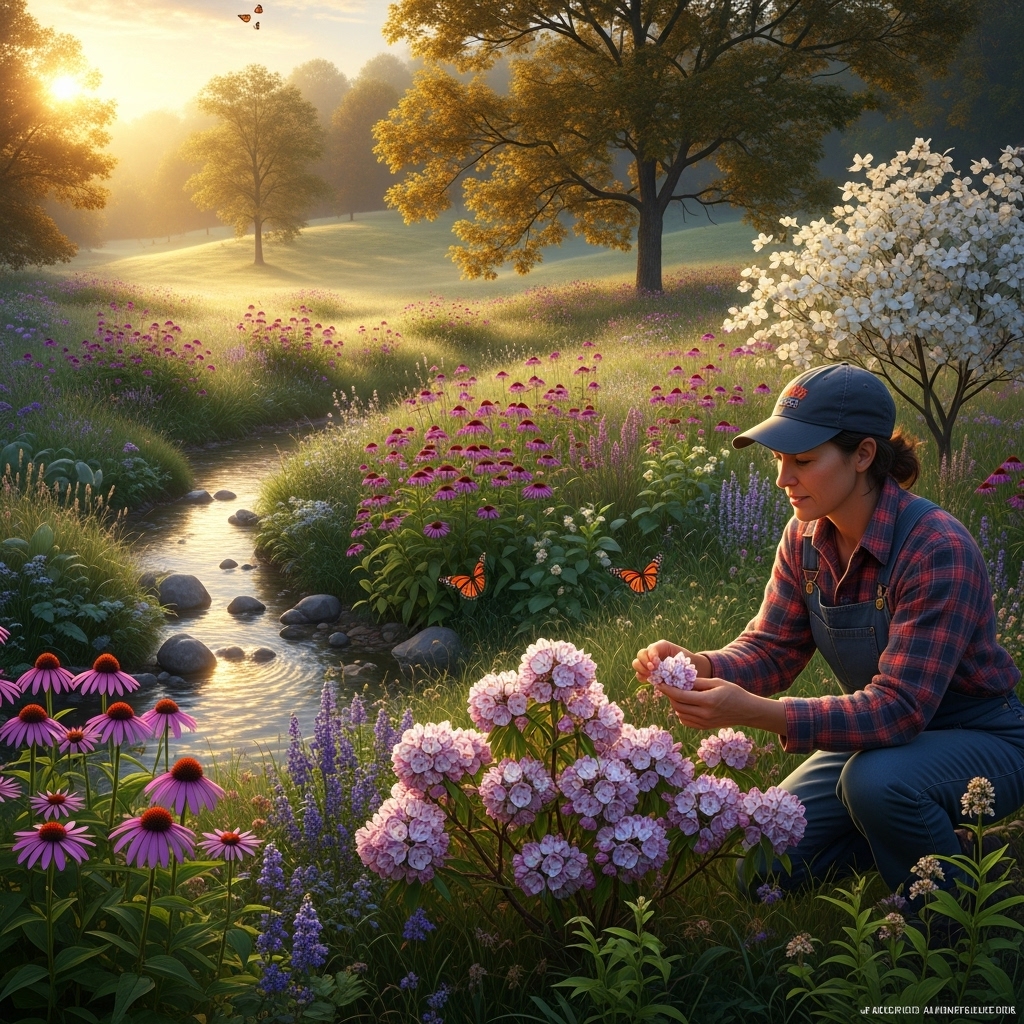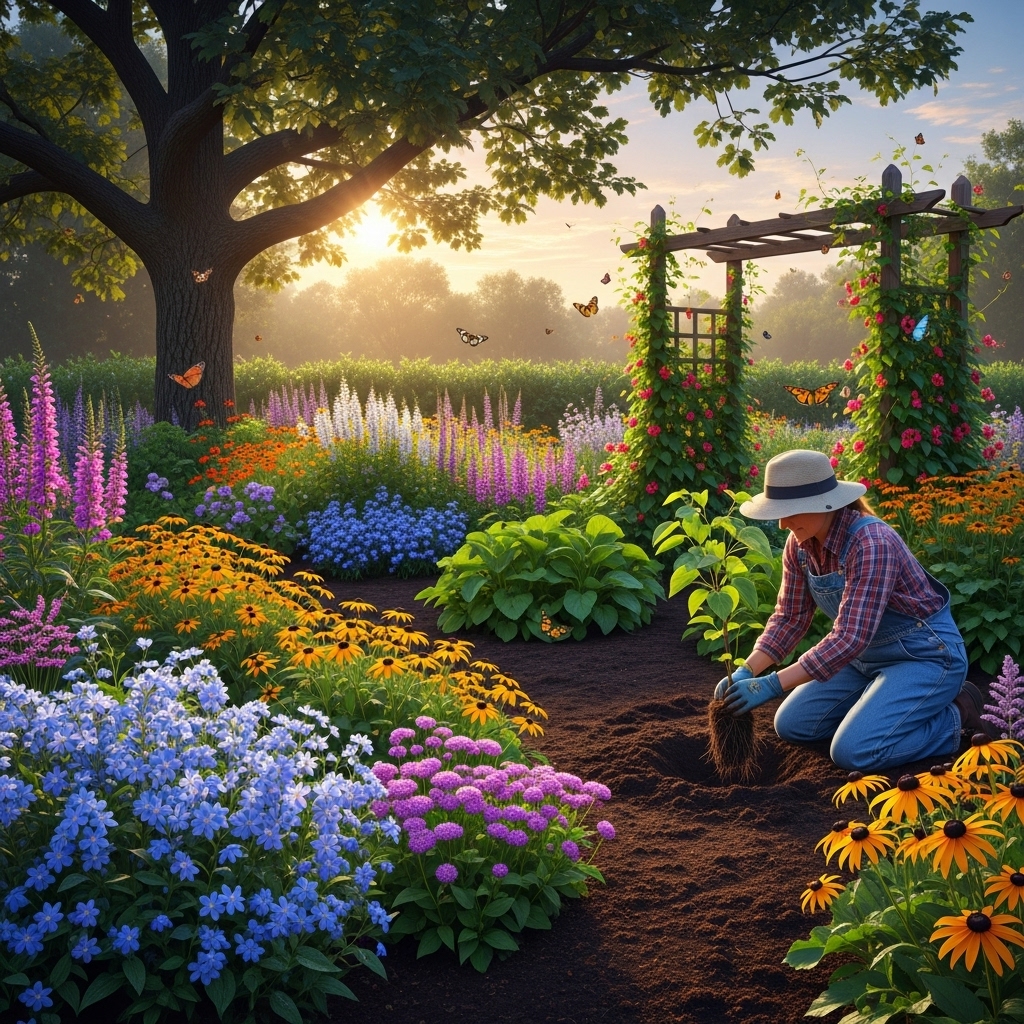Exploring the native plants from Virginia to Pennsylvania is an enriching journey for any gardener. These plants not only enhance our landscapes but also support local ecosystems, providing food and shelter for wildlife.
Discovering Native Flora: The Beauty of Virginia’s Landscape

As I stepped into the lush, vibrant world of Virginia’s native plants, I felt an instant connection to the land. The diverse ecosystems here have fostered an impressive array of flora, each species telling its own story of adaptation and resilience. Virginia’s landscapes range from the rolling hills of the Blue Ridge Mountains to the coastal plains, and each region boasts its own unique plants. Understanding these native species has transformed my gardening experience, allowing me to create a space that is not only beautiful but also ecologically beneficial.
Eastern Redbud (Cercis canadensis)
One of the first native plants I fell in love with is the Eastern Redbud. This small tree, with its heart-shaped leaves and stunning pink flowers, is a true herald of spring. In late March, I eagerly look out for its blossoms that emerge before the leaves, creating a breathtaking spectacle against the backdrop of still-bare branches. It’s not just visually appealing; the Eastern Redbud attracts pollinators like bees and butterflies, making it a valuable addition to any garden. I’ve planted several in my yard, and their cheerful blooms have brought endless joy to my family and me.
Common Milkweed (Asclepias Syriaca)
Next on my list is Common Milkweed, essential for anyone interested in supporting Monarch butterfly populations. The moment I noticed Monarchs flitting around my garden, I knew I had made the right choice. This perennial plant thrives in sunny spots and can tolerate a variety of soil conditions, making it an easy addition to any garden. The pinkish-purple flowers are not only beautiful but also rich in nectar, attracting a myriad of pollinators throughout the summer. I often find myself standing in awe as butterflies dance around the blooms, a reminder of the vital role native plants play in our ecosystem.
Pawpaw (Asimina triloba)
Another gem I’ve discovered is the Pawpaw tree, known for its delicious, custard-like fruit. I was intrigued when I learned that this North American native is the only host plant for the Zebra Swallowtail butterfly. The broad, dark green leaves provide a lush canopy, while the unique, droopy flowers emit a scent reminiscent of rotten meat, which surprisingly attracts pollinators. I planted a few pawpaw trees in a shaded area of my garden, and after a few years, I was rewarded with fruit. The sweet, tropical flavor was a delightful surprise, and I now cherish the moments spent enjoying the fruit with family and friends.
Wild Bergamot (Monarda fistulosa)
Wild Bergamot, or bee balm, is another fantastic native plant that has made its way into my garden. With its striking lavender flowers and aromatic foliage, it draws in not only bees but also hummingbirds. I love how it thrives in sunny spots and tolerates some drought, making it a low-maintenance choice for busy gardeners. Every summer, I look forward to the sight of the pollinators buzzing around the vibrant blossoms. Plus, I’ve started making herbal teas from its leaves, adding yet another layer of enjoyment to this already versatile plant.
Virginia Bluebell (Mertensia virginica)
If you’re seeking a plant that brings a burst of color in spring, the Virginia Bluebell is a must-have. This stunning wildflower features clusters of bell-shaped flowers that transition from pink to blue as they bloom. They thrive in moist, shady areas and have become a favorite of mine for naturalizing under trees. Each spring, I eagerly await their return, knowing they will herald the season’s change with their cheerful hues. They are also a favorite among pollinators, attracting bees and butterflies, and they create a breathtaking carpet of color that brings joy to anyone who sees them.
Buttonbush (Cephalanthus occidentalis)
Lastly, I can’t overlook the Buttonbush, a fascinating shrub that loves wet environments. Its spherical clusters of flowers resemble small buttons, providing a unique aesthetic to my garden. As a lover of diverse landscapes, I’ve made a space for Buttonbush near my pond, where it thrives. The flowers, which bloom in summer, attract a variety of pollinators, including butterflies and bees, creating a lively scene. Additionally, the shrub’s dense growth offers shelter for birds, making it a haven for wildlife. I find great pleasure in watching the activity around this plant, knowing I’ve created a welcoming environment for nature.
As I continue to explore the vast array of native plants from Virginia to Pennsylvania, I’m constantly amazed at how much beauty and ecological value these species bring to my garden. Each plant tells a story of the landscape and the wildlife it supports. By incorporating these native plants into my gardening practices, I not only enhance my own outdoor space but also contribute to the preservation of local ecosystems. The journey of discovery is ongoing, and I eagerly anticipate what other native plants I will uncover in the future.
Expanding My Garden: Native Plants of Pennsylvania

Venturing into Pennsylvania’s native plant landscape has been a delightful extension of my gardening journey. The state’s rich biodiversity and varying ecosystems have introduced me to a whole new world of flora that complements my Virginia garden beautifully. Just like in Virginia, the native plants here resonate with the land’s history and serve as vital components of their respective ecosystems. I’ve found that incorporating Pennsylvania natives into my garden not only adds visual interest but also enhances the ecological balance.
Pennsylvania Sedge (Carex pensylvanica)
One of my favorite discoveries in Pennsylvania is the Pennsylvania Sedge. This lovely grass-like plant is perfect for creating a lush carpet in shaded areas. What captivated me most about Pennsylvania Sedge is its adaptability. It thrives in dry to moist soils and can endure varying light conditions, making it an excellent choice for woodland gardens. Planting this sedge has transformed bare spots in my landscape into inviting, green spaces that are not only beautiful but also beneficial to local wildlife. I often find small birds foraging among the soft blades, which brings me immense joy.
Black-eyed Susan (Rudbeckia hirta)
The cheerful Black-eyed Susan is another essential addition to my garden, and it never fails to make me smile. Its bright yellow petals and dark centers are reminiscent of sunny summer days, and they have become a staple in my landscape. These perennials are hardy and drought-tolerant, making them a breeze to care for. Beyond their aesthetic appeal, Black-eyed Susans are incredibly valuable to local pollinators. I love watching the bees and butterflies drawn to their vibrant blooms, and I often find myself pausing to appreciate the life they bring to my garden.
Eastern Coneflower (Echinacea purpurea)
As I expanded my native plant collection, I couldn’t resist adding the Eastern Coneflower. This striking perennial features vibrant purple petals that radiate beauty and attract countless pollinators. I adore how they sway gently in the breeze and provide a stunning focal point in my flower beds. Not only are they aesthetically pleasing, but they are also known for their medicinal properties. I’ve started experimenting with homemade remedies, using the flowers and roots for teas, which adds a personal touch to my gardening experience.
Wild Columbine (Aquilegia canadensis)
Wild Columbine has become a favorite of mine, both for its delicate beauty and its historical significance. The drooping red and yellow flowers are like tiny lanterns that light up my garden in early spring. They thrive in partial shade and attract hummingbirds, which brings an enchanting element to my outdoor space. I love how they naturalize in rocky areas, often popping up in unexpected places, adding a touch of whimsy. It’s a plant that reminds me of the wild beauty of Pennsylvania’s woodlands.
American Bladdernut (Staphylea trifolia)
Exploring the shrubs of Pennsylvania led me to the American Bladdernut, a unique addition that I didn’t expect to love as much as I do. The plant’s whimsical, balloon-like seed pods and fragrant flowers are delightful surprises in my garden. I chose to plant a few along the edges of my property, where their dense foliage provides privacy and shelter for small wildlife. Watching the seed pods develop throughout the summer has been a fascinating experience, and I appreciate how they serve as a food source for birds during the winter months.
Wild Ginger (Asarum canadense)
Lastly, I’ve embraced Wild Ginger, a creeping ground cover that adds another layer of texture to my garden. Its heart-shaped leaves and unique, hidden flowers are a testament to the subtle beauty of nature. I planted it in a shaded area under my oak trees, where it thrives and fills in gaps beautifully. The aromatic roots have even sparked my interest in culinary uses. I’ve started experimenting with recipes that incorporate its flavor, connecting my gardening passion with my love for cooking.
The journey through Pennsylvania’s native plants has been as rewarding as my exploration of Virginia’s flora. Each new species I’ve introduced into my garden has deepened my appreciation for the natural world and highlighted the importance of biodiversity. With every plant, I feel more connected to the landscapes around me and the wildlife they support. I look forward to further exploring and integrating native plants into my garden, continually nurturing an ecosystem that thrives and flourishes.
Final Thoughts
Throughout my gardening journey, the exploration of native plants from Virginia to Pennsylvania has enriched my life in countless ways. Each plant I’ve discovered has its unique story, contributing not only to the beauty of my landscape but also to the health of the local ecosystem. As I continue to expand my garden, I remain passionate about choosing native species that honor the land and support wildlife. The rewards of this endeavor are immeasurable, and I look forward to sharing my experiences as I uncover even more native treasures.
